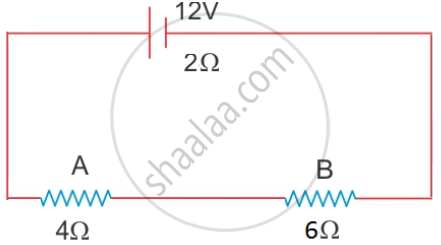Advertisements
Advertisements
Question
A battery of emf 12 V and internal resistance 2 Ω is connected with two resistors A and B of resistance 4 Ω and 6 Ω respectively joined in series.

Find:
1) Current in the circuit
2) The terminal voltage of the cell
3) The potential difference across 6Ω Resistor
4) Electrical energy spent per minute in the 4Ω resistor.
Solution
E = 12 V; ri = 2 Ω; RA = 4 Ω; RB = 6 Ω
1) The current in the circuit is
`I = E/R_"total" = E/(r_i + r_A + r_B)`
`:. I = 12/(2+4+6) = 1 A`
2) The terminal voltage of the cell is
V = E - Iri
∴ V = 12 - (1 x 2) = 12 - 2 = 10 V
3) The potential difference across the 6 Ω is
VB = IRB
∴ VB = 1 x 6 = 6V
4) The electrical energy spent per minute (=60 s) is
E = I2Rt
E = 12 X 4 X 60 = 240J
APPEARS IN
RELATED QUESTIONS
The values of current I flowing in a given resistor for the corresponding values of potential difference V across the resistor are given below:
| I (amperes) | 0.5 | 1.0 | 2.0 | 3.0 | 4.0 |
| V (volts) | 1.6 | 3.4 | 6.7 | 10.2 | 13.2 |
Plot a graph between V and I and calculate the resistance of that resistor.
Which of the following statements correctly defines a volt?
(a) a volt is a joule per ampere.
(b) a volt is a joule per coulomb.
What is the unit of electric charge?
How does the resistance of a metallic wire depend on its temperature? Explain with reason.
The following table shows current in Amperes and potential difference in Volts.
Which law will the graph prove? Explain the law.

A V-I graph for a nichrome wire is given below. What do you infer from this graph? Draw a labelled circuit diagram to obtain such a graph.

From the following observations taken while determining the resistance of a conductor, draw the current-voltage graph and calculate the resistance of conductor. Is the conductor ohmic?
| Ammeter reading I (in ampere) | Voltmeter reading V (in volt) |
| 0.2 | 0.4 |
| 0.3 | 0.6 |
| 0.5 | 1.0 |
| 0.8 | 1.6 |
| 1.5 | 3.0 |
A negative charge will move from ______ to ______ potential.
Name a device that helps to maintain a potential difference across conductors.
Two charged spherical conductors of radius R1 and R2 are connected by a wire. Then the ratio of surface charge densities of the spheres (σ1/σ2 ) is ______
